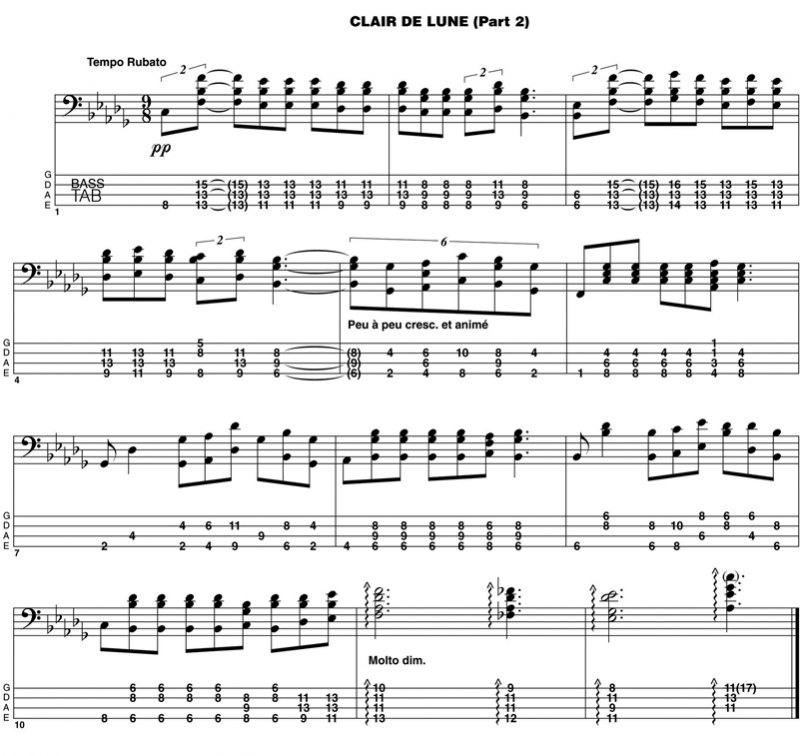Deep Thinking: Debussy Encore
Deep Thinking: Debussy Encore
This issue is the second part of the bass arrangement I have scored of Claude Debussy’s Claire de Lune. What happens after this section will require you to find three or four bass-playing mates, as the piece becomes impossible on one bass as it progresses. (Though you could add a couple of guitarists I suppose.)
As you can see, most of this section is made up of two- and three-note chords (double and triple stops). The phrase tempo rubato is at the top of the piece. This means that the tempo is more expressive and not restricted to a rigid tempo depending on how you feel it (unlike the normal bass playing role you will be used to). If you look at the tablature the fingerings are quite easy until you get to the last two quaver chords of bar 1.
These chords need you to stretch your fretting hand across five frets – finger 1 on Db at fret 9, finger 4 on Bb at fret 13, and finger 2 on Db on fret 11. This carries on into bar 2, although most of bar 2s chords fall neatly under your fingers. The quaver chords that have brackets with 2 over them are stretched, or sustained slightly longer. The same process applies to bar 5.
 The French instruction underneath the chords means get gradually louder and play more animatedly. I leave that interpretation to you but have a listen to the piece on Youtube. There is a four note chord in bar 6 in which fretting finger 4 plays the Ab, finger 3 plays the C, and finger 1 plays a barré (fretting both strings) at fret 1 for the Eb and Ab. The five-fret stretch occurs again in bar10, but thats the only tricky fingering in that bar.
The French instruction underneath the chords means get gradually louder and play more animatedly. I leave that interpretation to you but have a listen to the piece on Youtube. There is a four note chord in bar 6 in which fretting finger 4 plays the Ab, finger 3 plays the C, and finger 1 plays a barré (fretting both strings) at fret 1 for the Eb and Ab. The five-fret stretch occurs again in bar10, but thats the only tricky fingering in that bar.
The final two bars have wiggly lines down the sides of the chords. This means the chords are made up of notes played singly, a technique often referred to as playing broken chords from the bottom to the top (as indicated by the little arrow at the top of the chord). Fretting finger 4 plays the lowest note in each chord until you reach the final chord, which has fretting finger 1 playing Ab at fret 11, finger 3 playing Eb at fret 13, and finger 4 playing Gb at fret 11. As this is a broken chord, you could add the high C at fret 17 (which is in brackets).
The next issue is going to have some funk licks that were common in the street funk style of the 1970s and which have been used in various styles ever since – remember what I said a while back about Flea borrowing from Bootsy?
(Dr. Rob Burns is an Associate Professor in music at the University of Otago in Dunedin. As a former professional studio bassist in the UK, he performed and recorded with David Gilmour, Pete Townsend, Jerry Donahue, Isaac Hayes, Sam and Dave, James Burton, Ian Paice and Jon Lord, Eric Burdon and members of Abba. He played on soundtracks of many UK television shows, such as Red Dwarf, Mr. Bean, Blackadder, Not the Nine OClock News and Alas Smith and Jones. Rob is currently a member of Dunedin bands Subject2change and The Verlaines.)
